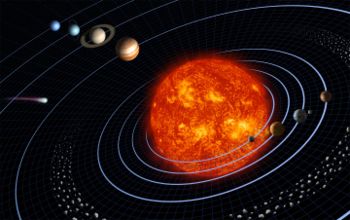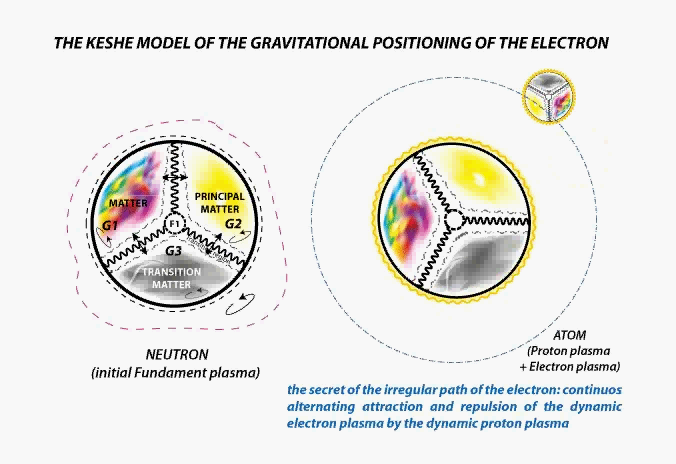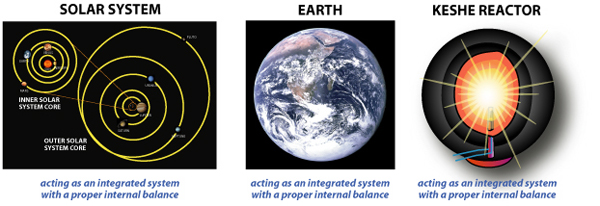|
New horizons
- Details
-
Category: A new horizon
 Gravitation between planets and starsScientists have long yearned to understand the secret intelligence of creation and the mechanisms behind the maintenance of energy, gravity and motion that has been achieved in the universe. Thanks to new insights into these mechanisms and to new methods and technologies that mirror them, we have found that a vast amount of energy and gravitational force can be generated within the core of a manmade reactor. Gravitation between planets and starsScientists have long yearned to understand the secret intelligence of creation and the mechanisms behind the maintenance of energy, gravity and motion that has been achieved in the universe. Thanks to new insights into these mechanisms and to new methods and technologies that mirror them, we have found that a vast amount of energy and gravitational force can be generated within the core of a manmade reactor.
The size of our reactors varies from as small as a rechargeable battery up to a few meters for large-scale power supply or for space applications.
The technology which has been developed is a totally integrated system capable of creating energy and gravity in its core. Within this system energy is produced by the same means that govern the natural dynamics of Earth, using geomagnetic forces and principles to create energy, dynamic magnetic fields and gravity.
We have proved that it is possible to achieve lift by using gravitational positioning and without the use of fuel. Thus by utilizing the basic forces of nature, man will be able to construct new systems for flight in space, free of manmade fuels and the shackles of Earth’s gravity.
Read more...
- Details
-
Category: Keshe neutron model
 The secret of the irregular path of the electron: continuous alternating attraction and repulsion of the dynamic electron plasma by the dynamic proton plasma. The secret of the irregular path of the electron: continuous alternating attraction and repulsion of the dynamic electron plasma by the dynamic proton plasma.
Read more...
- Details
-
Category: Keshe neutron model
THE KESHE NEUTRON MODEL
The neutron is composed of the three basic Matters (Matter, Dark Matter and Antimatter).
Read more...
- Details
-
Category: Gravity
SOURCE OF THE GRAVITY OF THE EARTH DISCOVERED
Nuclear engineer Mehran Keshe hypothesizes that a double magnetic field interaction lies at the core of gravitational effects in stars and planets, and in Earth. Such double magnetic fields determine also the interactions in and between atoms.
This hypothesis is based on the new understanding that the creation of the universe is based on interactions of Plasmatic Magnetic Energies (PME’s) which entangle in Specific Entangled Plasmatic Magnetic Fields (SEPMAF’s). These SEPMAF's represent energies which we call fundamental particles, and these can combine to form large complexes like atoms and then molecules. The next image shows the general concept.
Read more...
- Details
-
Category: Fields
Question from the forum by Samal4:
Just today, I received news from Reuters that a man can attract metallic objects to his body! Click the link below to see the video report based on this matter, and I wonder what's the cause for this man to operate such phenomenon.
Answer from MT Keshe:
Since human bodies are not all made of the same and exact combination of matters, hence they produce different Magravs, even though we all look as having the same two legs, arms and internal organs, but in truth different bodies can create different fields that these can attract or reject any matter or fields of any strength from his environment and as one can create fields of different strength, this means that different bodies are receptive to different field strength and matters and all human bodies can attract or reject different matters and fields as others.
Read more...
- Details
-
Category: Fields
Our general hypothesis is that the creation of matter does not require excess temperature or extreme pressure. The characteristics of all matters can be reproduced by altering the fundamental plasmatic magnetic energy (PME) of Specific Entangled Plasmatic Magnetic Fields (SEPMAF), as seen in PME A and PME B in the image below. SEPMAF's are what we call today in physics the fundamental parts of particles and atoms. Protons, neutrons and electrons are collections of SEPMAF's where their magnetic fields have a specific structural magnetic entanglement, for example the double plasmatic magnetic structure shown in the first image 1A.
Read more...
- Details
-
Category: First concept
In a feasibility study of 16 March 2005, a reputable scientist from a top university in Belgium wrote regarding the discovery of this new technology: “The principle described processes similar to the energy production in stars,” and he goes on to say, “The concept behind this method of energy production is feasible.”
 Solar ecological balance Solar ecological balanceThis technology is under continuous development and recent results from several static and dynamic working prototypes confirm the new insights. For example, for the first time we have managed to create atomic hydrogen and carbon as gas and as solid matter at room temperature and in atmospheric conditions. At present the conventional production of graphene needs temperatures of 700° to 800°C and the production CO2 as solid matter takes place at tens of degrees below zero. The production of atomic and wall/layer and multi-layered graphite through use of this new method has been confirmed by Raman spectroscopy carried out by leading institutes and universities in Europe. Through development of these technologies several international patents with over 300 potential uses have been filed in past years.
Read more...
- Details
-
Category: Dynamic reactors
 cola bottle plasma reactor with electrodes cola bottle plasma reactor with electrodesSeveral static and dynamic working prototypes confirm the new insights related to the PME's (Plasmatic Magnetic Energy) and the Keshe concept of SEPMAF's (Specific Entangled Plasmatic Magnetic Fields). The design and technology of our reactor systems has been developed in accordance with the same principles and methods that are seen in the physics of the universe, and similar effects have been achieved.
One of our simplest static plasma reactors is the cola bottle. This is equipped with a number of electrodes, from two to five. In this cola bottle reactor we achieve several outputs of voltage and current, we create atomic hydrogen and simultaneously we obtain deposits of atomic carbon on the electrodes. The working of these static reactors is not based on chemical interaction, as with acids, and the process is completely different from what happens in existing batteries. For example current is collected even from electrodes that are not submerged in the liquid, thus it is being collected from pure plasma. What’s more, the reactor recharges itself automatically while other terminals are generating voltage.
The main goal in performing these tests is to prove that the carbon from the gases inside the liquid can be collected and deposited on the electrodes. This demonstrates that the same principle can be utilized to separate carbon from the exhaust gases of cars and factories.
Read more...
|